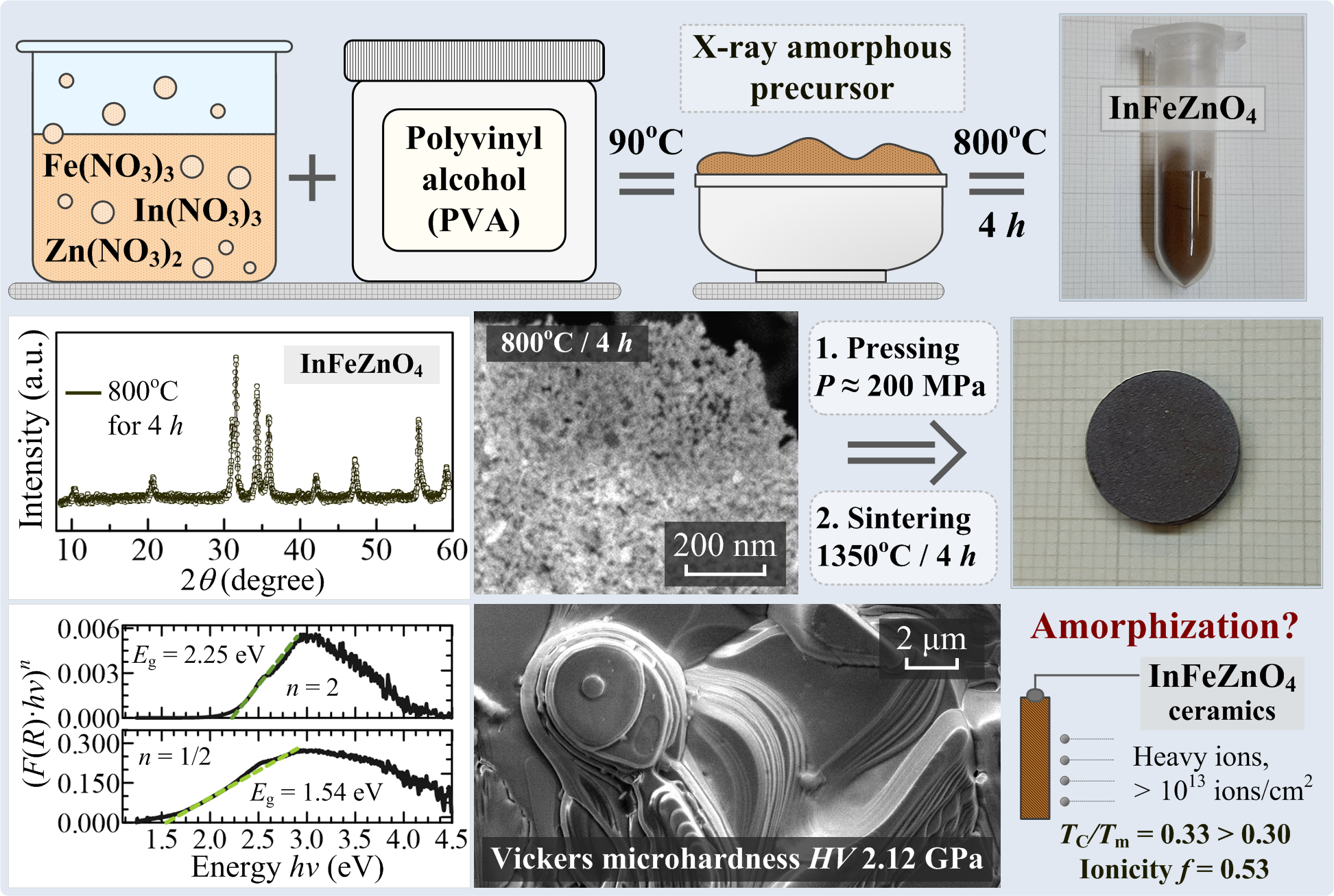Nanosystems: Phys. Chem. Math., 2024, 15 (5), 693–701
Ceramic materials prepared from nanocrystalline InFeZnO4 powder: optical and mechanical properties, and evaluation of radiation tolerance
Olga N. Kondrat’eva – Kurnakov Institute of General and Inorganic Chemistry of the Russian Academy of Sciences, Moscow, 119991, Russia; ol.kondratieva@gmail.com
Maria N. Smirnova – Kurnakov Institute of General and Inorganic Chemistry of the Russian Academy of Sciences, Moscow, 119991, Russia; smirnovamn@igic.ras.ru
Galina E. Nikiforova – Kurnakov Institute of General and Inorganic Chemistry of the Russian Academy of Sciences, Moscow, 119991, Russia; gen@igic.ras.ru
AlexeyD. Yapryntsev – Kurnakov Institute of General and Inorganic Chemistry of the Russian Academy of Sciences, Moscow, 119991, Russia; yapryntsev@igic.ras.ru
Dmitriy F. Kondakov – Kurnakov Institute of General and Inorganic Chemistry of the Russian Academy of Sciences, Moscow, 119991, Russia; oldradio@mail.ru
LeonidD. Yagudin – Frumkin Institute of Physical Chemistry and Electrochemistry of the Russian Academy of Sciences, Moscow, 119071, Russia; yagudinld@icloud.com
Corresponding author: O. N. Kondrat’eva, ol.kondratieva@gmail.com
PACS 81.07.Wx, 62.20.Qp, 78.20.-e
DOI 10.17586/2220-8054-2024-15-5-693-701
ABSTRACT A method for low-temperature synthesis of InFeZnO4 oxide from an X-ray amorphous precursor formed as a result of the thermal decomposition of dehydration product of a mixture of polyvinyl alcohol and iron, indium, and zinc nitrate solutions has been developed. Using TG/DSC and XRD, the InFeZnO4 phase has been shown to be formed in the temperature range of 370–420 °C. Using the XRD method, after the heat treatment of the precursor at 800 °C for 4 hours, nanocrystalline InFeZnO4 with an average particle size (CSR) of ≈36 nm has been found to be formed. According to SEM, they do not have a clear facet and form a homogeneous cellular microstructure of the powder. The absence of organic residues and moisture in it has been confirmed by FTIR spectroscopy. From the DRS data, it has been found that the band gap energy Eg of InFeZnO4 for the cases of indirect and direct transitions is 1.54 eV and 2.25 eV, respectively. Ceramics produced from nanocrystalline InFeZnO4 by high-temperature sintering have a density equal to 5160 kg/m3 (≈86 % of the theoretical one). Their microhardness, measured by the Vickers method, is 2.12 GPa. The radiation resistance of InFeZnO4 has been predicted, from which it follows that, when exposed to intermediate and high doses of ionizing radiation, its partial amorphization is the most likely.
KEYWORDS Indium-iron-zinc oxide; rhombohedral crystal structure; X-ray amorphous precursor; nanoscale powders; sintering; ceramics; microhardness; band gap energy; radiation tolerance.
FUNDING This study was performed within the ARIADNA Collaboration operating under the NICA facility as a part of State Assignment of the IGIC RAS “Solving topical problems with NICA charged particle beams” (ref. #1024050300012-6-1.4.2).
ACKNOWLEDGEMENTS The measurements were performed using the equipment of the JRC PMR IGIC RAS. The microhardness studies were carried out using the equipment of the CKP FMI IPCE RAS.
FOR CITATION Kondrat’eva O.N., Smirnova M.N., Nikiforova G.E., Yapryntsev A.D., Kondakov D.F., Yagudin L.D. Ceramic materials prepared from nanocrystalline InFeZnO4 powder: optical and mechanical properties, and evaluation of radiation tolerance. Nanosystems: Phys. Chem. Math., 2024, 15 (5), 693–701.
[In Russian] Кондратьева О.Н., Смирнова М.Н., Никифорова Г.Е., Япрынцев АД., Кондаков Д.Ф., Ягудин Л.Д.
Керамические материалы из нанокристаллического оксида InFeZnO4: оптические и механические свойства и оценка радиационной стойкости
АННОТАЦИЯ Разработан способ низкотемпературного синтеза оксида InFeZnO4 из рентгеноаморфного прекурсора, образующегося в результате термического разложения продуктов дегидратации смеси поливинилового спирта и растворов нитратов железа, индия и цинка. С помощью ТГ/ДСК и РФА показано, что фаза InFeZnO4 образуется в температурном интервале 370–420 °C. Методом РФА установлено, что после термической обработки прекурсора при 800 °C в течение 4 ч образуется нанокристаллический InFeZnO4 со средним размером частиц (ОКР) ≈ 36 нм. По данным РЭМ, они не имеют четкой огранки и образуют однородную, ячеистую микроструктуру порошка. Отсутствие органических остатков и влаги в нем подтверждено методом ИК-спектроскопии. Из данных СДО найдено, что ширина запрещенной зоны Eg InFeZnO4 для случая непрямых и прямых переходов составляет 1.54 эВ и 2.25 эВ, соответственно. Керамика, изготовленная из нанокристаллического InFeZnO4 методом высокотемпературного спекания, имеет плотность, равную 5160 кг/м3 (≈ 86% от теоретической). Ее микротвердость, измеренная по методу Виккерса, равна 2.12 ГПа. Спрогнозирована радиационная стойкость InFeZnO4. Из результатов прогноза следует, что при воздействии на материал средних и высоких доз ионизирующего излучения наиболее вероятна его частичная аморфизация.
КЛЮЧЕВЫЕ СЛОВА Оксид индия-железа-цинка; ромбоэдрическая решетка; рентгеноаморфный прекурсор; наноразмерные порошки; спекание; керамика; микротвердость; ширина запрещенной зоны; радиационная стойкость
